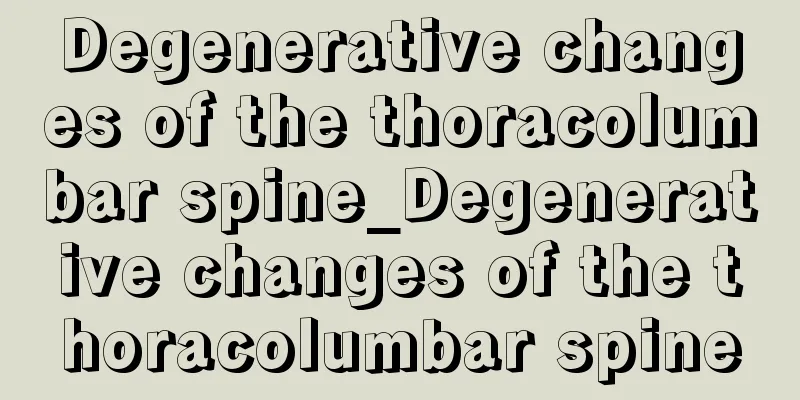Degenerative changes of the thoracolumbar spine_Degenerative changes of the thoracolumbar spine

|
I believe that many people do not know the cause of thoracic and lumbar degenerative changes, nor do they know the symptoms of this disease, so we should learn more about relevant medical knowledge. Thoracolumbar degenerative changes refer to the symptoms of natural aging and degeneration of the lumbar spine. This symptom usually occurs in the elderly, causing us to have difficulty in movement and a shorter lumbar standing time, affecting our quality of life. Lumbar degenerative disease refers to the physiological and pathological process of natural aging and degeneration of the lumbar spine. The lumbar spine is the hub of human trunk movement, and all body activities increase the burden on the lumbar spine. With age, excessive activity and overload accelerate the aging of the lumbar spine. Severe lumbar degenerative diseases can cause low back and leg pain and even nerve damage, affecting work ability and quality of life. Causes 1. Degeneration of the lumbar disc annulus The intervertebral disc tissue bears the weight of the human trunk and upper limbs, and is more susceptible to strain than other tissues in daily life and labor. The lumbar intervertebral disc has a small blood supply and extremely limited nutrition, making it very prone to degeneration. Studies have shown that the intervertebral discs have already started to degenerate when people are approaching their 20s, and some have already undergone obvious degeneration between the ages of 20 and 30, with cracks forming in the annulus fibrosus. The intervertebral discs of people over 30 years old all have degeneration. As age increases, the annulus fibrosus of the intervertebral disc undergoes reticular degeneration and hyaline degeneration, loses its original layers and toughness, develops various cracks, and then completely ruptures. 2. Degeneration of the nucleus pulposus of the intervertebral disc The nucleus pulposus of the intervertebral disc is a tissue rich in water and small molecular elastic mucoglycoprotein. It contains chondrocytes and fibroblasts. The water content can reach more than 80% in childhood, which decreases with age and can reach 70% in old age. The amount of water content in the intervertebral disc determines its intrinsic pressure level and elastic state. Degeneration of the nucleus pulposus often occurs on the basis of degeneration of bone joints and annulus fibrosus. When the load on the lumbar spine increases, the intervertebral space pressure increases and the degeneration of the intervertebral disc accelerates, the cracks in the annulus fibrosus deepen, and the degenerated nucleus pulposus protrudes to the edge along the cracks, which causes lumbar disc herniation. 3. Degeneration of cartilage endplate The cartilage endplates of the intervertebral disc become thinner, calcified, and incomplete with age, and produce cystic changes and chondrocyte necrosis. The attachment points of the annulus fibrosus loosen, accompanied by a decrease in the water content of the nucleus pulposus, and the cartilage endplates cannot be regenerated and repaired. Degeneration of the cartilage endplate will reduce the function of the translucent membrane in the exchange of intervertebral disc fluid and accelerate the degeneration of the lumbar disc. 4. Degeneration of lumbar vertebrae After the surface of the lumbar vertebra is damaged, hematomas form above and below the periosteum, fibroblasts become active, and gradually grow into the hematoma, replacing the hematoma with granulation tissue. As the hematoma becomes organized and calcified, osteophytes (bone spurs) are eventually formed, protruding into the spinal canal or out of the vertebral body. The formation of osteophytes is a protective measure of the body, which can stabilize the vertebrae, avoid abnormal activities and increase the weight-bearing plane. However, the development of osteophytes in the spinal canal and pedicles will compress the spinal nerves and dura mater sac and cause different nerve root compression symptoms. 5. Degeneration of lumbar facet joints The intervertebral disc and facet joints form a triangular support structure between the vertebrae to stabilize the relationship between the vertebrae. When the lumbar spine degenerates or the intervertebral joints are damaged, the stability of the facet joints is destroyed and pathological changes occur. The lumbar joint stability decreases, the joint space and intervertebral foramen narrow, and the nerve roots are compressed, resulting in symptoms. 6. Degeneration of the ligamentum flavum The yellow ligament is the main ligament in the spinal canal. The thickness of normal people is 2 to 4 cm, and it can reach more than 6 to 8 cm when it proliferates. The normal ligamentum flavum is loose and elastic. When degeneration and injury occur, the yellow ligament is in a state of tension, gradually proliferating and thickening, reducing its elasticity, and calcifying and ossifying, compressing the dura mater sac of the spinal canal and causing secondary spinal stenosis. 7. Degeneration of other ligaments The anterior and posterior longitudinal ligaments of the vertebral body play an important role in stabilizing the lumbar spine. If fibrous hyperplasia and sclerosis occur, the movement of the lumbar spine will be restricted. 8. Bone hyperplasia The production of bone hyperplasia is a response to enhance stability and resist lumbar spine pressure. After the intervertebral disc herniates, the annulus fibrosus relaxes, the intervertebral disc's compression resistance and stability are weakened, resulting in bone hyperplasia. Even if there is a herniated intervertebral disc, bone hyperplasia will occur as long as the stability of the degenerative lumbar vertebra changes. 9. Degenerative Spinal Stenosis Spinal stenosis is classified according to its cause into congenital spinal stenosis and secondary spinal stenosis. Spinal stenosis refers to a compression syndrome of nerve roots, cauda equina, etc. caused by stenosis of the spinal canal, nerve root canal, and intervertebral foramen. When the intervertebral disc. Degeneration of the annulus fibrosus, articular processes and ligaments may compress the spinal canal, causing the diameter of the spinal canal to become smaller and narrower. |
<<: Can I soak my feet when I have internal heat?
>>: Degenerative changes of meniscus
Recommend
Are there any side effects of grinding cheekbones when you get older?
In life, many people are dissatisfied with their ...
Pazopanib kidney cancer drug side effects
Pazopanib kidney cancer drug side effects: The si...
Breast cancer chemotherapy and radiotherapy survival period
Breast cancer chemotherapy and radiotherapy survi...
How to treat double vision?
In layman's terms, double vision means that p...
Do you know how long a colorectal cancer patient can live?
How long can you live with colorectal cancer? Thi...
Can gout patients eat cake?
Gout is a common clinical disease. People of all ...
What are some ways to enhance facial muscles?
When people reach a certain age, their facial mus...
The difference between weak alkaline water and pure water
Many people have heard that the body has acidity ...
How to treat fear of death, psychological therapy is very important
Death is a physiological norm. We should treat it...
What to do if the pain is severe after liver cancer ablation
What should I do if I feel severe pain after live...
What are some tips in life
Life is full of surprises. A small item or a litt...
Eyelid swelling caused by mosquito bites_Eyelid swelling caused by mosquito bites
In summer, there are a lot of mosquitoes, and the...
Experts summarize common care methods for brain cancer patients
Now, the incidence of brain cancer is increasing ...
How is hamartoma generally treated?
The human body is complex, and human diseases are...
What should not be taken with iron supplements?
It is best to choose iron supplements. Not only c...









